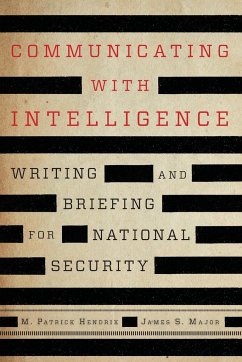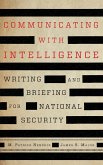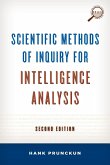M. Patrick Hendrix, James S. Major
Communicating with Intelligence
Writing and Briefing for National Security
M. Patrick Hendrix, James S. Major
Communicating with Intelligence
Writing and Briefing for National Security
- Broschiertes Buch
- Merkliste
- Auf die Merkliste
- Bewerten Bewerten
- Teilen
- Produkt teilen
- Produkterinnerung
- Produkterinnerung
This book outlines the foundations of good intelligence communication, a toolkit for writing these documents, the briefing process, and a guide to citations and classified materials.
Andere Kunden interessierten sich auch für
![Communicating with Intelligence Communicating with Intelligence]() M. Patrick HendrixCommunicating with Intelligence183,99 €
M. Patrick HendrixCommunicating with Intelligence183,99 €![Quantitative Intelligence Analysis Quantitative Intelligence Analysis]() Edward WaltzQuantitative Intelligence Analysis115,99 €
Edward WaltzQuantitative Intelligence Analysis115,99 €![Quantitative Intelligence Analysis Quantitative Intelligence Analysis]() Edward WaltzQuantitative Intelligence Analysis50,99 €
Edward WaltzQuantitative Intelligence Analysis50,99 €![The Handbook of African Intelligence Cultures The Handbook of African Intelligence Cultures]() The Handbook of African Intelligence Cultures164,99 €
The Handbook of African Intelligence Cultures164,99 €![Reasoning for Intelligence Analysts Reasoning for Intelligence Analysts]() Noel HendricksonReasoning for Intelligence Analysts81,99 €
Noel HendricksonReasoning for Intelligence Analysts81,99 €![The Academic-Practitioner Divide in Intelligence Studies The Academic-Practitioner Divide in Intelligence Studies]() The Academic-Practitioner Divide in Intelligence Studies159,99 €
The Academic-Practitioner Divide in Intelligence Studies159,99 €![Scientific Methods of Inquiry for Intelligence Analysis Scientific Methods of Inquiry for Intelligence Analysis]() Hank PrunckunScientific Methods of Inquiry for Intelligence Analysis94,99 €
Hank PrunckunScientific Methods of Inquiry for Intelligence Analysis94,99 €-
-
-
This book outlines the foundations of good intelligence communication, a toolkit for writing these documents, the briefing process, and a guide to citations and classified materials.
Hinweis: Dieser Artikel kann nur an eine deutsche Lieferadresse ausgeliefert werden.
Hinweis: Dieser Artikel kann nur an eine deutsche Lieferadresse ausgeliefert werden.
Produktdetails
- Produktdetails
- Security and Professional Intelligence Education Series
- Verlag: Rowman & Littlefield
- Third Edition
- Seitenzahl: 310
- Erscheinungstermin: 27. Oktober 2022
- Englisch
- Abmessung: 229mm x 152mm x 18mm
- Gewicht: 492g
- ISBN-13: 9781538160671
- ISBN-10: 1538160676
- Artikelnr.: 64264674
- Herstellerkennzeichnung
- Libri GmbH
- Europaallee 1
- 36244 Bad Hersfeld
- gpsr@libri.de
- Security and Professional Intelligence Education Series
- Verlag: Rowman & Littlefield
- Third Edition
- Seitenzahl: 310
- Erscheinungstermin: 27. Oktober 2022
- Englisch
- Abmessung: 229mm x 152mm x 18mm
- Gewicht: 492g
- ISBN-13: 9781538160671
- ISBN-10: 1538160676
- Artikelnr.: 64264674
- Herstellerkennzeichnung
- Libri GmbH
- Europaallee 1
- 36244 Bad Hersfeld
- gpsr@libri.de
Dr. Patrick Hendrix is a professor in the Department of Intelligence Analysis and Security Studies at The Citadel Military College.
Preface
Introduction - Jan Goldman
Part I: The Foundations of Good Intelligence Communication
1. What It's All About
Bottom Line Up Front Analysts: The Voice of the Intelligence Community
Getting Started:
Consider the Reader
The Style of Good Intelligence Writing: Bottom Line Upfront
Three Goals of Intelligence Writing: Judge, Interpret, Support
Real World Problems
Four differences Between Academic and Intelligence Writing
Making the Distinction Clear - Especially for Students
Facilitating the Process
Final Thoughts and Exercises
Notes
2. Using Argument in Intelligence Writing
Bottom Line Up Front
What is an Argument?
Formulating a Thesis Statement
Argument Reflects How Humans Think
Evaluating Arguments
Final Thoughts and Exercises
3. Reading: Fundamental to Writing
Bottom Line Up Front
Read to Write
The Forms of Intelligence: Basic, Current, Estimative
Examining Content
Evaluating Finished Intelligence
Graphics: Attention Grabbers
Final Thoughts and Exercises
Part II: Writing with Intelligence
4. Research Methods
Bottom Line Up Front
Time Management
Searching, Researching
Evaluating Sources
Final Thoughts and Exercises
5. Analysis Check
Bottom Line Up Front
Structured Analytic Techniques
Final Thoughts and Exercises
6. Prewriting
Bottom Line Up Front
Finding Your Subject
Focusing on Form and Format
Finding Time and Managing Length
Prewriting Tools: Building a Foundation
Final Thoughts and Exercises
7. Writing the First Draft
Bottom Line Up Front
Drafting: Get Right To It
Set Realistic Goals and Pace Yourself
Clarity: Be Kind to Your Reader
Time to Get Organized
Transitions: Moving Smoothly Ahead
Introductions: Not Methodology
The Body of Your Writing
Drafting Conclusion: The Role of Intelligence Writing
Final Thoughts and Exercises
8. Finishing a Draft
Bottom Line Up Front
A Model Process for Revising an Analytical Paper
Constraints on Review
Reviewer and Writer's Experience
Basic Revision Techniques
Thesis and Overview Statements
Commonly Asked Questions about Revision
Ten Questions to Help You Examine Your Own Writing Process
Exercises in Writing Analytical Papers
Part III: Briefing with Intelligence
9. Scripting Your Briefing
Bottom Line Up Front
A Disclaimer: Read and Heed
A Brief Typology of Briefings
The Organization, Mission, and Functions Briefing
The ABCs of Good Intelligence Briefings and Briefers
Get Started: Get Organized
Prewrite
Analyze Your Audience
Outline Your Thoughts
Writing the Script
Pointers for Writing the Script
Use of Notes
Using Visual Aids
Putting Words and Pictures Together
Final Thoughts and Exercises
10. Briefing the Customer
Bottom Line Up Front
Appearance: Make First Impressions Count
Cognizance: Knowledge Really Is Power
Final Thoughts and Exercises
11. Citing Your Sources
12. Handling and Citing Classified Material
Appendix A: Memo for the Director and Deputy Director from Vice Chairman of
the National Intelligence Council Herbert E. Meyer
Appendix B: FBI Intelligence Estimate
Appendix C: Briefing Evaluation Form
Bibliography
Dictionaries and Thesauruses
Sources for Writing Style, Grammar, and Composition
Sources for Analysis and Research
Briefing-Related Sources
Other Sources Used or Consulted for This Book
About the author
Index
Introduction - Jan Goldman
Part I: The Foundations of Good Intelligence Communication
1. What It's All About
Bottom Line Up Front Analysts: The Voice of the Intelligence Community
Getting Started:
Consider the Reader
The Style of Good Intelligence Writing: Bottom Line Upfront
Three Goals of Intelligence Writing: Judge, Interpret, Support
Real World Problems
Four differences Between Academic and Intelligence Writing
Making the Distinction Clear - Especially for Students
Facilitating the Process
Final Thoughts and Exercises
Notes
2. Using Argument in Intelligence Writing
Bottom Line Up Front
What is an Argument?
Formulating a Thesis Statement
Argument Reflects How Humans Think
Evaluating Arguments
Final Thoughts and Exercises
3. Reading: Fundamental to Writing
Bottom Line Up Front
Read to Write
The Forms of Intelligence: Basic, Current, Estimative
Examining Content
Evaluating Finished Intelligence
Graphics: Attention Grabbers
Final Thoughts and Exercises
Part II: Writing with Intelligence
4. Research Methods
Bottom Line Up Front
Time Management
Searching, Researching
Evaluating Sources
Final Thoughts and Exercises
5. Analysis Check
Bottom Line Up Front
Structured Analytic Techniques
Final Thoughts and Exercises
6. Prewriting
Bottom Line Up Front
Finding Your Subject
Focusing on Form and Format
Finding Time and Managing Length
Prewriting Tools: Building a Foundation
Final Thoughts and Exercises
7. Writing the First Draft
Bottom Line Up Front
Drafting: Get Right To It
Set Realistic Goals and Pace Yourself
Clarity: Be Kind to Your Reader
Time to Get Organized
Transitions: Moving Smoothly Ahead
Introductions: Not Methodology
The Body of Your Writing
Drafting Conclusion: The Role of Intelligence Writing
Final Thoughts and Exercises
8. Finishing a Draft
Bottom Line Up Front
A Model Process for Revising an Analytical Paper
Constraints on Review
Reviewer and Writer's Experience
Basic Revision Techniques
Thesis and Overview Statements
Commonly Asked Questions about Revision
Ten Questions to Help You Examine Your Own Writing Process
Exercises in Writing Analytical Papers
Part III: Briefing with Intelligence
9. Scripting Your Briefing
Bottom Line Up Front
A Disclaimer: Read and Heed
A Brief Typology of Briefings
The Organization, Mission, and Functions Briefing
The ABCs of Good Intelligence Briefings and Briefers
Get Started: Get Organized
Prewrite
Analyze Your Audience
Outline Your Thoughts
Writing the Script
Pointers for Writing the Script
Use of Notes
Using Visual Aids
Putting Words and Pictures Together
Final Thoughts and Exercises
10. Briefing the Customer
Bottom Line Up Front
Appearance: Make First Impressions Count
Cognizance: Knowledge Really Is Power
Final Thoughts and Exercises
11. Citing Your Sources
12. Handling and Citing Classified Material
Appendix A: Memo for the Director and Deputy Director from Vice Chairman of
the National Intelligence Council Herbert E. Meyer
Appendix B: FBI Intelligence Estimate
Appendix C: Briefing Evaluation Form
Bibliography
Dictionaries and Thesauruses
Sources for Writing Style, Grammar, and Composition
Sources for Analysis and Research
Briefing-Related Sources
Other Sources Used or Consulted for This Book
About the author
Index
Preface
Introduction - Jan Goldman
Part I: The Foundations of Good Intelligence Communication
1. What It's All About
Bottom Line Up Front Analysts: The Voice of the Intelligence Community
Getting Started:
Consider the Reader
The Style of Good Intelligence Writing: Bottom Line Upfront
Three Goals of Intelligence Writing: Judge, Interpret, Support
Real World Problems
Four differences Between Academic and Intelligence Writing
Making the Distinction Clear - Especially for Students
Facilitating the Process
Final Thoughts and Exercises
Notes
2. Using Argument in Intelligence Writing
Bottom Line Up Front
What is an Argument?
Formulating a Thesis Statement
Argument Reflects How Humans Think
Evaluating Arguments
Final Thoughts and Exercises
3. Reading: Fundamental to Writing
Bottom Line Up Front
Read to Write
The Forms of Intelligence: Basic, Current, Estimative
Examining Content
Evaluating Finished Intelligence
Graphics: Attention Grabbers
Final Thoughts and Exercises
Part II: Writing with Intelligence
4. Research Methods
Bottom Line Up Front
Time Management
Searching, Researching
Evaluating Sources
Final Thoughts and Exercises
5. Analysis Check
Bottom Line Up Front
Structured Analytic Techniques
Final Thoughts and Exercises
6. Prewriting
Bottom Line Up Front
Finding Your Subject
Focusing on Form and Format
Finding Time and Managing Length
Prewriting Tools: Building a Foundation
Final Thoughts and Exercises
7. Writing the First Draft
Bottom Line Up Front
Drafting: Get Right To It
Set Realistic Goals and Pace Yourself
Clarity: Be Kind to Your Reader
Time to Get Organized
Transitions: Moving Smoothly Ahead
Introductions: Not Methodology
The Body of Your Writing
Drafting Conclusion: The Role of Intelligence Writing
Final Thoughts and Exercises
8. Finishing a Draft
Bottom Line Up Front
A Model Process for Revising an Analytical Paper
Constraints on Review
Reviewer and Writer's Experience
Basic Revision Techniques
Thesis and Overview Statements
Commonly Asked Questions about Revision
Ten Questions to Help You Examine Your Own Writing Process
Exercises in Writing Analytical Papers
Part III: Briefing with Intelligence
9. Scripting Your Briefing
Bottom Line Up Front
A Disclaimer: Read and Heed
A Brief Typology of Briefings
The Organization, Mission, and Functions Briefing
The ABCs of Good Intelligence Briefings and Briefers
Get Started: Get Organized
Prewrite
Analyze Your Audience
Outline Your Thoughts
Writing the Script
Pointers for Writing the Script
Use of Notes
Using Visual Aids
Putting Words and Pictures Together
Final Thoughts and Exercises
10. Briefing the Customer
Bottom Line Up Front
Appearance: Make First Impressions Count
Cognizance: Knowledge Really Is Power
Final Thoughts and Exercises
11. Citing Your Sources
12. Handling and Citing Classified Material
Appendix A: Memo for the Director and Deputy Director from Vice Chairman of
the National Intelligence Council Herbert E. Meyer
Appendix B: FBI Intelligence Estimate
Appendix C: Briefing Evaluation Form
Bibliography
Dictionaries and Thesauruses
Sources for Writing Style, Grammar, and Composition
Sources for Analysis and Research
Briefing-Related Sources
Other Sources Used or Consulted for This Book
About the author
Index
Introduction - Jan Goldman
Part I: The Foundations of Good Intelligence Communication
1. What It's All About
Bottom Line Up Front Analysts: The Voice of the Intelligence Community
Getting Started:
Consider the Reader
The Style of Good Intelligence Writing: Bottom Line Upfront
Three Goals of Intelligence Writing: Judge, Interpret, Support
Real World Problems
Four differences Between Academic and Intelligence Writing
Making the Distinction Clear - Especially for Students
Facilitating the Process
Final Thoughts and Exercises
Notes
2. Using Argument in Intelligence Writing
Bottom Line Up Front
What is an Argument?
Formulating a Thesis Statement
Argument Reflects How Humans Think
Evaluating Arguments
Final Thoughts and Exercises
3. Reading: Fundamental to Writing
Bottom Line Up Front
Read to Write
The Forms of Intelligence: Basic, Current, Estimative
Examining Content
Evaluating Finished Intelligence
Graphics: Attention Grabbers
Final Thoughts and Exercises
Part II: Writing with Intelligence
4. Research Methods
Bottom Line Up Front
Time Management
Searching, Researching
Evaluating Sources
Final Thoughts and Exercises
5. Analysis Check
Bottom Line Up Front
Structured Analytic Techniques
Final Thoughts and Exercises
6. Prewriting
Bottom Line Up Front
Finding Your Subject
Focusing on Form and Format
Finding Time and Managing Length
Prewriting Tools: Building a Foundation
Final Thoughts and Exercises
7. Writing the First Draft
Bottom Line Up Front
Drafting: Get Right To It
Set Realistic Goals and Pace Yourself
Clarity: Be Kind to Your Reader
Time to Get Organized
Transitions: Moving Smoothly Ahead
Introductions: Not Methodology
The Body of Your Writing
Drafting Conclusion: The Role of Intelligence Writing
Final Thoughts and Exercises
8. Finishing a Draft
Bottom Line Up Front
A Model Process for Revising an Analytical Paper
Constraints on Review
Reviewer and Writer's Experience
Basic Revision Techniques
Thesis and Overview Statements
Commonly Asked Questions about Revision
Ten Questions to Help You Examine Your Own Writing Process
Exercises in Writing Analytical Papers
Part III: Briefing with Intelligence
9. Scripting Your Briefing
Bottom Line Up Front
A Disclaimer: Read and Heed
A Brief Typology of Briefings
The Organization, Mission, and Functions Briefing
The ABCs of Good Intelligence Briefings and Briefers
Get Started: Get Organized
Prewrite
Analyze Your Audience
Outline Your Thoughts
Writing the Script
Pointers for Writing the Script
Use of Notes
Using Visual Aids
Putting Words and Pictures Together
Final Thoughts and Exercises
10. Briefing the Customer
Bottom Line Up Front
Appearance: Make First Impressions Count
Cognizance: Knowledge Really Is Power
Final Thoughts and Exercises
11. Citing Your Sources
12. Handling and Citing Classified Material
Appendix A: Memo for the Director and Deputy Director from Vice Chairman of
the National Intelligence Council Herbert E. Meyer
Appendix B: FBI Intelligence Estimate
Appendix C: Briefing Evaluation Form
Bibliography
Dictionaries and Thesauruses
Sources for Writing Style, Grammar, and Composition
Sources for Analysis and Research
Briefing-Related Sources
Other Sources Used or Consulted for This Book
About the author
Index








